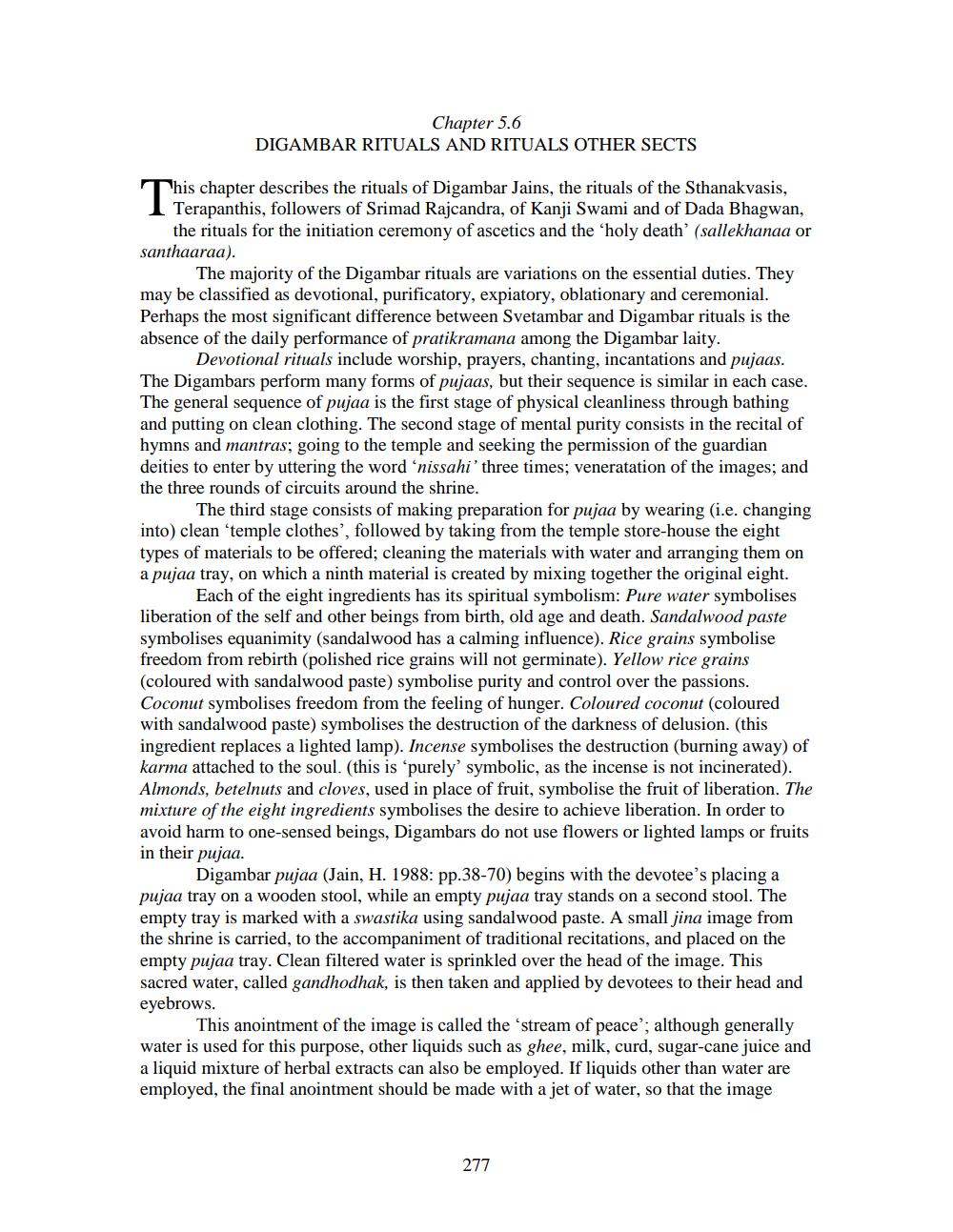________________
Chapter 5.6 DIGAMBAR RITUALS AND RITUALS OTHER SECTS
This chapter describes the rituals of Digambar Jains, the rituals of the Sthanakvasis, I Terapanthis, followers of Srimad Rajcandra, of Kanji Swami and of Dada Bhagwan,
the rituals for the initiation ceremony of ascetics and the 'holy death' (sallekhanaa or santhaaraa).
The majority of the Digambar rituals are variations on the essential duties. They may be classified as devotional, purificatory, expiatory, oblationary and ceremonial. Perhaps the most significant difference between Svetambar and Digambar rituals is the absence of the daily performance of pratikramana among the Digambar laity.
Devotional rituals include worship, prayers, chanting, incantations and pujaas. The Digambars perform many forms of pujaas, but their sequence is similar in each case. The general sequence of pujaa is the first stage of physical cleanliness through bathing and putting on clean clothing. The second stage of mental purity consists in the recital of hymns and mantras, going to the temple and seeking the permission of the guardian deities to enter by uttering the word 'nissahi' three times; veneratation of the images, and the three rounds of circuits around the shrine.
The third stage consists of making preparation for pujaa by wearing (i.e. changing into) clean 'temple clothes', followed by taking from the temple store-house the eight types of materials to be offered; cleaning the materials with water and arranging them on a pujaa tray, on which a ninth material is created by mixing together the original eight.
Each of the eight ingredients has its spiritual symbolism: Pure water symbolises liberation of the self and other beings from birth, old age and death. Sandalwood paste symbolises equanimity (sandalwood has a calming influence). Rice grains symbolise freedom from rebirth (polished rice grains will not germinate). Yellow rice grains (coloured with sandalwood paste) symbolise purity and control over the passions. Coconut symbolises freedom from the feeling of hunger. Coloured coconut (coloured with sandalwood paste) symbolises the destruction of the darkness of delusion. (this ingredient replaces a lighted lamp). Incense symbolises the destruction (burning away) of karma attached to the soul. (this is 'purely' symbolic, as the incense is not incinerated). Almonds, betelnuts and cloves, used in place of fruit, symbolise the fruit of liberation. The mixture of the eight ingredients symbolises the desire to achieve liberation. In order to avoid harm to one-sensed beings, Digambars do not use flowers or lighted lamps or fruits in their pujaa.
Digambar pujaa (Jain, H. 1988: pp.38-70) begins with the devotee's placing a pujaa tray on a wooden stool, while an empty pujaa tray stands on a second stool. The empty tray is marked with a swastika using sandalwood paste. A small jina image from the shrine is carried, to the accompaniment of traditional recitations, and placed on the empty pujaa tray. Clean filtered water is sprinkled over the head of the image. This sacred water, called gandhodhak, is then taken and applied by devotees to their head and eyebrows.
This anointment of the image is called the stream of peace'; although generally water is used for this purpose, other liquids such as ghee, milk, curd, sugar-cane juice and a liquid mixture of herbal extracts can also be employed. If liquids other than water are employed, the final anointment should be made with a jet of water, so that the image
277




